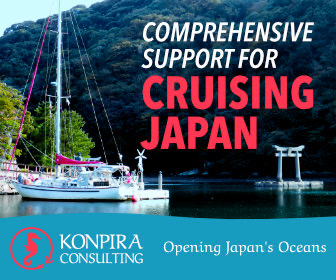Cruising in Japan just got a whole lot easier!
Japan has recently changed the permit necessary to visit closed ports, making it much simpler to get a cruising permit that is valid indefinitely and free of charge. Does this mean Japan could now be on the shortlist for one of the best cruising grounds in the world?
Published 7 years ago, updated 6 years ago


The Ministry of Land, Infrastructure, Transport, and Tourism (MILT) is responsible for granting port permission to visiting yachts. Many foreign cruisers have reported over the years that the application process was very cumbersome, all the information was in Japanese, and the rules and procedures were applied inconsistently.
In 2016, finally, the entire process became a lot easier when an English-language website was launched and applications could be handled via e-mail. However, foreign cruisers still had to submit a detailed list of the closed ports that they wanted to enter (or might want to enter), and this had to be done every year they were in Japan. This complicated procedure and tedious paperwork is what has given Japan a very negative reputation among the cruising community.
The good news is that a new system has been introduced (effective May 7, 2018) which means that foreign cruisers in Japan for sightseeing purposes (i.e., not for commercial purposes) can now apply, upon entering Japan, for a “blanket” closed-port permit that allows them to enter all closed ports at any time. The application is a very simple one-page form available on the MILT website. The permit is valid indefinitely (as long as the boat is in Japan and its ownership, name, home address, etc. remain unchanged), with no need for permit renewals.
Officially when visiting open ports (large commercial ports), one is required to submit Customs and Coast Guard Port Entry and Port Departure forms, but the Coast Guard offices in many open ports often waive that requirement based on local criteria, such as exempting pleasure vessels or boats under 20 tons. Foreign boats can be exempted from doing the Customs open port paperwork by requesting registration as a domestic (coastal) cruising boat — “naiko senpaku” – on arrival in Japan (that does not, however, exempt boats from Coast Guard paperwork requirements or the closed-port permit requirement).
Probably the “icing on the cake” is that the permit is free and there are no fees for cruising Japan.
As before, there is no limit on how long a foreign boat can stay in Japan, and there is no need to request permission to leave the boat in the country long term, no registration requirements, no import duties, etc.
Of course, visa rules only allow a foreigner to stay in Japan for 180 days in every 12 month period and cruisers report that Immigration is enforcing this rule more strictly these days. So one can cruise in Japan for 6 months, leave the boat in a marina for 6 months while one goes home (or travels elsewhere in Asia), and then come back for another 6 months of cruising.
On arrival, one gets a 90-day or 180-day visa, depending on one’s passport; if 90 days, one can renew for another 90 days in Japan or, more commonly, make a quick “visa run” to Korea.
Kirk of SV Silk Purse, who has kept his boat in Japan for 5 years and submitted this report to noonsite, neatly summarises the meaning of this recent change: “I know that Japan has a negative reputation among many cruises because of its bureaucracy and paperwork, but the new closed-port cruising permit eliminates a lot of the causes of that reputation. Local officials can still sometimes be a pain (especially as they often don’t know the rules themselves), but overall I would say that Japan — with its great people, amazing history/culture, fantastic food, safety, and many other positive attributes — is now one of the best cruising grounds in the world. By being able to go wherever one wants whenever one wants, and by being able to leave the boat in Japan as long as one wants — all for no fees and minimal paperwork — makes it an even greater place to cruise”.
The MILT website is not yet updated with the new form, however, the old form (which can be used in the meantime) can be found at http://www.mlit.go.jp/en/maritime/specialpermission.html [BROKEN LINK]
Related content
Related to following destinations: Japan








Update from Kirk Patterson who got a new “closed port permit” last week:
I got my new closed-port permit on Thursday, as promised. The wording of the new permit is very simple…and vague…it is just one sentence that basically says “The application for a closed-port permit by Canadian vessel Silk Purse has been approved as submitted”!!
No mention of unrestricted permission to enter all closed ports nor any mention of its open-ended (indefinite) validity? Japanese vagueness to a T! I just hope that all the local Japanese officials know what it means! (Actually, in my five years of cruising Japan, I have only once ever been asked to show my closed-port permit!). Anyway, this a very encouraging development.